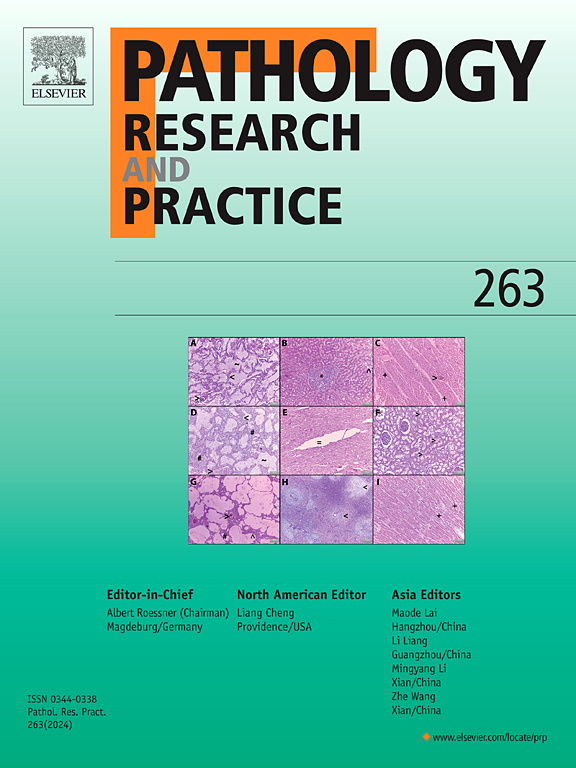Taming hyper-active Cdk5: Disrupting the Cdk5–p25 axis as a therapeutic avenue for neurodegeneration and beyond
IF 3.2
4区 医学
Q2 PATHOLOGY
引用次数: 0
Abstract
Cyclin-dependent kinase 5 (Cdk5) is essential for neuronal development and synaptic function when activated by its physiological cofactors p35 and p39. Pathological calpain cleavage of p35 generates the more stable fragment p25, producing a hyperactive, mislocalized kinase complex that has been implicated in tau hyperphosphorylation, DNA damage, neuroinflammation, and aberrant neuronal cell-cycle re-entry. Three decades of work position the Cdk5–p25 axis as a convergent pathogenic mechanism in Alzheimer’s disease and related dementias, Parkinson’s disease, traumatic brain injury, and in subsets of metabolic and solid-tumor contexts. High-resolution structures of Cdk5–p25 reveal a distinctive activation-loop “cradle” and a tract leading toward catalytic Lys33 that enable structure-guided inhibitor design. Recent advances include (i) small molecules that “vector” toward Lys33 and achieve ∼70–125 × selectivity over closely related CDKs in biochemical assays, (ii) brain-penetrant peptide disruptors that preferentially inhibit Cdk5–p25 while sparing basal Cdk5–p35 signaling in rodent models, and (iii) early-stage degradation or genetic approaches (e.g., dual-target PROTACs; calpain-resistant p35 or Cdk5 knockdown) that reduce p25 signaling or Cdk5 levels in cells. Across inducible mouse models, toxin paradigms, and tumor xenografts, interventions that blunt the p25-driven switch ameliorate cognitive deficits, preserve dopaminergic neurons, improve insulin secretion in β-cell models, and slow tumor growth, respectively. Key translational challenges include achieving durable brain exposure, defining the long-term safety of partial kinase suppression, establishing fluid biomarkers for human studies, and anticipating compensatory signaling. Multiple mechanistic classes are in preclinical development, placing precise disruption of Cdk5–p25 on a credible path toward clinical testing across neurology, oncology, and metabolic disease.
驯服过度活跃的Cdk5:破坏Cdk5-p25轴作为神经退行性疾病及其他疾病的治疗途径
周期蛋白依赖性激酶5 (Cdk5)在其生理辅助因子p35和p39的激活下对神经元发育和突触功能至关重要。p35的病理性钙蛋白酶裂解产生更稳定的片段p25,产生一个过度活跃的、错误定位的激酶复合物,该复合物与tau过度磷酸化、DNA损伤、神经炎症和异常的神经元细胞周期再进入有关。三十年的研究表明,Cdk5-p25轴是阿尔茨海默病和相关痴呆、帕金森病、创伤性脑损伤以及代谢性和实体肿瘤亚群的趋同致病机制。Cdk5-p25的高分辨率结构揭示了一个独特的激活环“摇篮”和一个通向催化Lys33的通道,使结构导向抑制剂设计成为可能。最近的进展包括(i)小分子“载体”Lys33,并在生化分析中对密切相关的CDKs实现~ 70-125 × 选择性,(ii)脑渗透肽干扰物优先抑制Cdk5-p25,同时在啮鼠模型中保留基础Cdk5-p35信号传导,以及(iii)早期降解或遗传方法(例如,双靶点PROTACs; calpaine抗性p35或Cdk5敲低)减少细胞中p25信号传导或Cdk5水平。在诱导小鼠模型、毒素范式和肿瘤异种移植中,钝化p25驱动开关的干预措施分别改善了认知缺陷、保护了多巴胺能神经元、改善了β细胞模型中的胰岛素分泌,并减缓了肿瘤生长。关键的翻译挑战包括实现持久的脑暴露,确定部分激酶抑制的长期安全性,建立用于人体研究的液体生物标志物,以及预测代偿信号。多种机制类别正在临床前开发中,将Cdk5-p25的精确破坏置于神经病学,肿瘤学和代谢疾病的临床试验的可信路径上。
本文章由计算机程序翻译,如有差异,请以英文原文为准。
求助全文
约1分钟内获得全文
求助全文
来源期刊
CiteScore
5.00
自引率
3.60%
发文量
405
审稿时长
24 days
期刊介绍:
Pathology, Research and Practice provides accessible coverage of the most recent developments across the entire field of pathology: Reviews focus on recent progress in pathology, while Comments look at interesting current problems and at hypotheses for future developments in pathology. Original Papers present novel findings on all aspects of general, anatomic and molecular pathology. Rapid Communications inform readers on preliminary findings that may be relevant for further studies and need to be communicated quickly. Teaching Cases look at new aspects or special diagnostic problems of diseases and at case reports relevant for the pathologist''s practice.

 求助内容:
求助内容: 应助结果提醒方式:
应助结果提醒方式:


